Lanham is an unincorporated community and census-designated place in Prince George's County, Maryland, United States. As of the 2020 United States Census it had a population of 11,282. The New Carrollton station as well as an Amtrak station are across the Capital Beltway in New Carrollton, Maryland. Doctors Community Hospital is located in Lanham.

Piscataway is an unincorporated community in Prince George's County, Maryland, United States. It is one of the oldest European-colonized communities in the state. The Piscataway Creek provided sea transportation for export of tobacco. It is located near the prior Piscataway tribe village of Kittamaqundi.
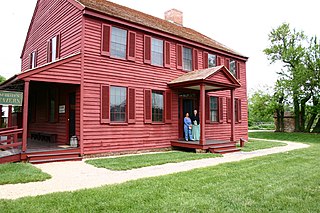
The Surratt House is a historic house and house museum located at 9110 Brandywine Road in Clinton, Prince George's County, Maryland, United States. The house is named for John and Mary Surratt, who built it in 1852. Mary Surratt was hanged in 1865 for being a co-conspirator in the Abraham Lincoln assassination. It was acquired by the Maryland-National Capital Park and Planning Commission (M-NCPPC) in 1965, restored, and opened to the public as a museum in 1976.

Marietta, is a historic home located in Glenn Dale, Prince George's County, Maryland.

St. Ignatius Church is a Roman Catholic parish church of the Archdiocese of Washington located at 2315 Brinkley Rd., Fort Washington, MD 20744, in Oxon Hill, Prince George's County, Maryland. The historic church structure was constructed between 1890 and 1891. The 1+1⁄2-story structure is wood frame, with clapboarding, and shingling in imbricated pattern. It is rectangular in form with a gabled roof, 80-foot (24 m) projecting front belfry with spire and louvered openings, round arched openings, and modified corner buttresses. The architectural style is considered Eclectic, with elements of the Shingle and Queen Anne styles. It is the second church on site and has served as a mission and parish church. The original church, built in 1849, was partially funded by Mary Surratt, one of the conspirators involved with the Assassination of Abraham Lincoln.

Abraham Hall, constructed in 1889, is located on the northeast side of Old Muirkirk Road in the center of the historic African American community of Rossville, a section of Prince George's County, Maryland near Beltsville.

The Chapel of the Incarnation is an L-shaped church building of the Mission style. It is located at 14070 Brandywine Rd., Brandywine, Prince George's County, Maryland.

Beall's Pleasure is a historic home located in Landover, Prince George's County, Maryland, United States. The original owner of the land was Colonel Ninian Beall. He helped establish the first Presbyterian Church in Prince George's County. It was built in 1795 as the summer home of Benjamin Stoddert who later became the first Secretary of the Navy.
Brookefield of the Berrys is a historic house located at Croom, Prince George's County, Maryland, United States. It is a 2+1⁄2-story frame house begun about 1810 in the Federal style, and completed in 1840, in the Greek Revival style. The house was finished in 1840 by John Thomas Berry, a prominent plantation family in southern Prince George's County. Berry and his descendants lived at Brookefield from 1840 until 1976. This 19th-century farmstead is well represented by the complex of outbuildings surrounding the house.

The Butler House was a historic home of importance to local African American history and located at Oxon Hill, Prince George's County, Maryland, United States. Henry Alexander Butler, a free African American man from Charles County, moved with his family to the property in 1853, and the property has been continuously associated with the Butler family. Henry Butler became a Reconstruction era community leader, serving as trustee of the nearby Freedmen's Bureau school. The Butler House was a 2+1⁄2-story, one room deep wood-frame and log residence covered in cast stone. It sat in a secluded, forested area, adjacent to the Oxon Hill Children's Farm. As of December 2010, the house is in a severely dilapidated condition. In 2020 the house collapsed and the property was sold in 2019.

Hazelwood is a historic home located outside Upper Marlboro, Prince George's County, Maryland, United States. The home is a large asymmetrical frame dwelling, built in three discrete sections over a long period of time. They are: a low gambrel-roofed section dating from the 18th century, about 1770; a gable-roofed Federal-style dwelling dating from the very early 19th century; and a tall gable-front Italianate-style central section constructed about 1860. The house stands on high ground west of and overlooking the site of historic Queen Anne town on the Patuxent River. Also on the property are several domestic and agricultural outbuildings, and the reputed sites of two cemeteries.
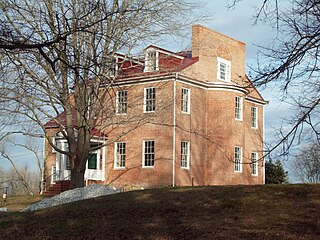
Melford is a historic plantation house located on the grounds of the Maryland Science and Technology Center, near the intersection of U.S. Route 301 and U.S. Route 50, at Bowie, Prince George's County, Maryland. The house is multi-part, gable-roofed, brick and stone dwelling house constructed probably in the mid-late 1840s, with elements of the Greek Revival style.

St. Mary's Beneficial Society Hall, constructed in 1892, is a historic building located in Upper Marlboro, Prince George's County, Maryland.
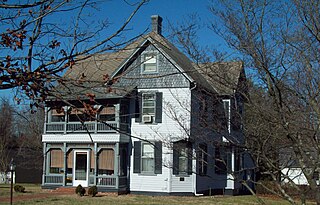
The John H. Traband House is a historic home located at Upper Marlboro in Prince George's County, Maryland, United States. It was built between 1895 and 1897, and is a 2+1⁄2-story, asymmetrically shaped Queen Anne influenced frame structure of modest size and detailing. Also located on the property are a frame two-story gable-roofed carriage house. The house was constructed as the residence of a prominent citizen, John H. Traband (1857–1938), who was a successful businessman and landholder in Upper Marlboro.
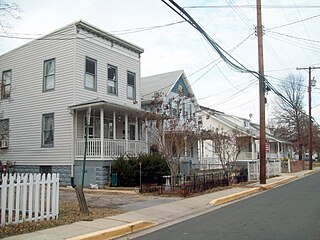
The North Brentwood Historic District, is a national historic district located in the town of North Brentwood, Prince George's County, Maryland. It was the earliest incorporated African American community in the county. The historic district comprises 128 buildings reflecting its development over the period from 1891 to 1950. All of the early vernacular dwellings were of wood-frame construction with Late Victorian inspiration. The 1920s house forms represented included bungalows, multi-family houses, and larger Foursquares. Small brick cottages were primarily built in the period immediately following World War II. The surviving historic buildings illustrate the forms and styles of buildings typically constructed in working-class suburban communities of the period.
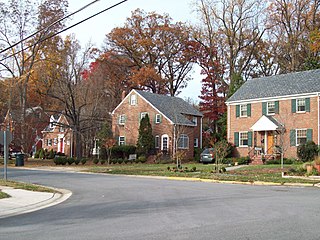
The University Park Historic District is a national historic district located in the town of University Park, Prince George's County, Maryland. The district encompasses 1,149 contributing buildings and 2 contributing sites and is almost exclusively residential and developed as a middle-class, automobile suburb of Washington, D.C. The primary building type is the detached single-family dwelling, with the only non-residential buildings within the district and the town being two churches and the Town Hall, which is located in a former residence. Notable features within the district include the property's original plantation house, known as Bloomfield, and the nearby family cemetery. It was developed over the period 1920 to 1945, and houses are built in a range of popular early-20th-century architectural styles including Tudor and Mediterranean Revival, and varied interpretations of the Craftsman Aesthetic and the Colonial Revival, including interpretations of Dutch, Georgian, and Federal period substyles.

St. Thomas Manor (1741) is a historic home and Catholic church complex located near Port Tobacco, Charles County, Maryland. Known as St. Ignatius Church and Cemetery, the manor house complex is the oldest continuously occupied Jesuit residence in the world. The mission settlement of Chapel Point was established in 1641 by Father Andrew White, S.J., an English Jesuit missionary. Father White administered to the Potapoco Native Americans, some of whom he converted to Catholicism. Established in 1662, this is the oldest continuously active Roman Catholic parish in the American Thirteen Colonies. With the consecration in 1794 of Bishop John Carroll, St. Thomas became the first Roman Catholic see in the United States.

St. Thomas' Episcopal Parish Historic District is a national historic district located at Croom, Prince George's County, Maryland. The district encompasses four contributing buildings and three contributing sites associated with St. Thomas' Church. The other contributing buildings are the Gothic Revival style St. Thomas' Church Rectory (1852-1853), Tenant/Sexton's House, and tobacco barn. The contributing sites are the St. Thomas' Episcopal Church Cemetery, St. Simon's Mission Chapel Site, and St. Simon's Cemetery. The African-American communicants of St. Thomas' Church formed St. Simon's Mission Chapel in the late-19th century and it operated on the property associated with the Croome Industrial and Agricultural School, which operated from about 1902 to 1952.
The Upper Marlboro Residential Historic District is a national historic district encompassing a historic residential area of Upper Marlboro, Maryland. The area reflects the town's growth from the 18th to the 20th century, including its importance as the county seat of Prince George's County. The district also contained a significant post-American Civil War African-American population, which was making the transition from slavery to freedom. Located in the district are three previously listed properties: Kingston, Content, and the John H. Traband House. Prominent features of the district include the Trinity Episcopal Church at 14519 Church Street, an 1846 Gothic Revival church designed by Robert Carey Long, Jr., and 5415 Old Crain Highway, a 1+1⁄2-story wood-frame house dated to c. 1730, which is believed to be the oldest building in the town.

Isaiah T. Hatton (1883–1921) was an architect in the United States known for his designs of buildings for his fellow African Americans. Several are listed on the National Register of Historic Places.





















